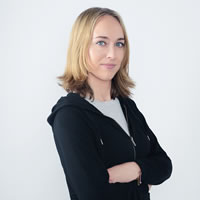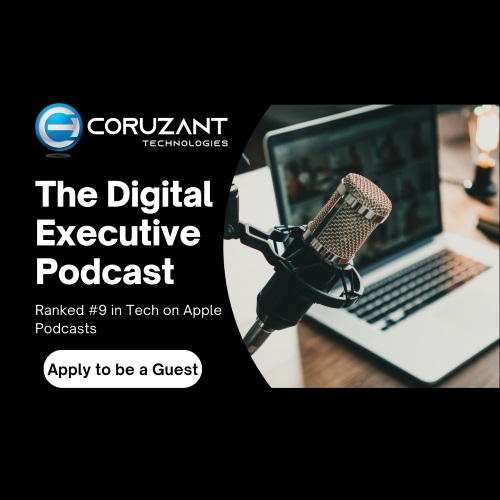Sarah Nagy Podcast Transcript
Sarah Nagy joins host Brian Thomas on The Digital Executive Podcast.
Welcome to Coruzant Technologies, Home of The Digital Executive Podcast.
Brian Thomas: Welcome to The Digital Executive. Today’s guest is Sarah Nagy, a former data scientist. Sarah Nagy serves as Co-founder and CEO of Seek AI, an emerging analytics automation startup based in New York. Sarah most recently led the consumer data team at Citadel’s Azure Capital and prior to Citadel, led the quant arms at two successfully exited startups and developed algorithmic trading strategies at ITG.
Sarah has a master’s degree in finance from Princeton and dual bachelor’s degrees in astrophysics and business economics from UCLA.
Well, good afternoon, Sarah. Welcome to the show!
Sarah Nagy: Thank you so much for having me!
Brian Thomas: Absolutely. Love talking about data and we’re going to have some really fun stuff to talk about today.
So again, Sarah, I appreciate you making the time hailing out of that New York area. And we’re going to jump right into the question here. What inspired you to transition from leading data teams at Citadel and other startups to founding Seek AI? Can you share that story behind its inception?
Sarah Nagy: Yeah, I was leading data teams or working as a, you know, individual contributor for over a decade in, you know, mostly financial services and also a couple of startups.
And so, I had basically been working with data for a long time. Prior to that, I actually came from a research background. I was actually an astrophysicist at UCLA in Caltech. And, you know, it’s kind of what motivated me to go into this career path of working with data because I really wanted to be doing, you know, research and all the cool data sets that were available to me.
And so, what ended up kind of motivating me to start seek was it was a combination of a pain point. I kept experiencing and also, you know, a technology that I was seeing developing. So, in terms of the pain point, I basically was spending a lot of my time doing pretty manual work. And I wasn’t necessarily expecting it, and it also felt kind of inefficient.
Some of that work involved helping non-technical people just get, you know, very basic answers that they needed to questions that they had about data or putting together like quick reports for non-technical people. So, I get a lot of people come out to my desk asking me to put together a heat map or whatever it was that they needed.
And that kind of resulted in me going into the data and often writing a bunch of code. And it just felt like very repetitive code that I was writing over and over again, but never quite the same. So, it was really hard to automate. And then at the same time, basically started following large language models around 2018 and by 2020, I noticed that they were much, much better at code generation, which I thought was like the coolest thing ever.
And that’s, you know, around 2021, 2020, that’s when it started occurring to me. Like, wow, these models could start automating a lot of this work that I’m doing, you know, every day. And that was really the origin of Seek. I ended up starting Seek September 2021. And yeah, it was basically those two trends really ended up converging.
Brian Thomas: Thank you for sharing that story and I appreciate you really wanting to do better for yourself or your customers writing a lot of code, but you actually found a solution to a problem. And that’s what really gets me excited because there’s a lot of entrepreneurs that come on the podcast and talk about their story, which.
Of course, everybody’s story is unique, but at the end of the day, they’re trying to make the world a better place and really help people be more efficient at what they do. So, I appreciate that. And Sarah, next question. How has your experience in developing algorithmic trading strategies in leading quant arms influenced your approach to analytics and automation at Seek AI?
Sarah Nagy: Well, I think it makes my background maybe a little bit unusual for a data scientist. I started out doing, I guess it was pretty hardcore, you know, I was a quantitative analyst working on very large data sets that were related to, you know, trading data at I think like less than nanosecond frequencies, which isn’t even considered high frequency, but it’s pretty high frequency to me.
So yeah, I was, you know, working on classical machine learning algorithms. And I was really more of a quant and a data scientist throughout my career working with machine learning algorithms. But at the same time, the field that I got pretty interested in was called alternative data. Which means very large, unusual the data sets, you know, for example, like when you hear about wants to look at satellite data at head funds trying to like count cars in parking lots at Walmart or whatever, that kind of data, you know, working with that kind of data requires good data analysis skills as well, not just data science.
And alternative data ended up being the focus of my career for, you know, basically every company I worked, worked at after ITG, which was my first job. And, you know, because of that, I ended up doing quite a lot of data analysis. You know, descriptive analytics in addition to machine learning and data science, which is more what I was trained in.
So, I think that did kind of give me this unique perspective because I saw how painful and mundane a lot of data analysis was. And I was also learning a lot about the type of technology that could be used to automate these kinds of mundane pieces. So that, that kind of background, I think, was pretty helpful for me to have, to be able to form SEEK.
But yeah, I would say that’s how developing those trading strategies ended up helping me.
Brian Thomas: Thank you. Appreciate that. And absolutely. There’s obviously a lot of analytical work that you did in these areas that certainly contributes to what you’re doing today. So, I appreciate the backstory on that, Sarah and Sarah, can you elaborate on the core technologies and innovations that seek AI is leveraging to differentiate itself in the analytics automation space?
Sarah Nagy: Well, I would say the biggest technology is definitely large language models. You know, we’ve been building large language models since the very beginning of Seek. It was kind of the whole reason I decided to start the company. You know, I was just noticing how much better the models were getting.
And, you know, code generation is the core of what we do. So how the product actually works is it’s really meant for everybody in a business to be able to use. To ask questions that they have about the data and be able to get answers faster and, you know, have processes in place to ensure that the answers are accurate.
So, in addition to using large language models to generate the kind of code that’s needed to get those answers. We also have other technology that we’ve invented as well. We actually have two patents pending from 2022 and 2023 involving certain types of guardrails around, you know, quality checking the outputs of large language models and making sure that things aren’t in there that we don’t want, like hallucinations, which I think everyone’s heard of at this point.
You know, another innovation was last year, we set the record on an academic benchmark called the Yale spider benchmark, which is, you know, basically measuring machine learning model quality on turning text into data. And so, yeah, in addition to the technology that already existed, we were able to bring some of our own technology into the world as well.
Brian Thomas: I love that, you know, you’re constantly innovating, you know, I do know that you’re leveraging some of those LLMs and generative AI, but I know over time with some of your ingenuity, some of your ideas combined with some of the technologies that are out there today, you’re going to make seek AI the next big thing.
So, I appreciate that. And Sarah, last question of the day. How do you see the role of analytics and data science evolving over the next 5 to 10 years? And what role do you envision? Seek AI playing in this future?
Sarah Nagy: I think it’s a really interesting question. And I think probably the number 1 thing is, you know, basically increasing awareness.
And adoption of natural language querying for data. I think a lot of companies need this, you know, a lot of companies have lots of data and not a lot of data people to analyze it. So as a result, a lot of that data just gets underutilized and the return that I think companies are hoping to get. Just is not achieved because, you know, you can really only have a small fraction of your employees accessing the data and asking new questions and getting new answers and taking action on that.
And so, this year, we’ve seen more awareness already, you know, businesses wanting to query their data with natural language, and I definitely see that increasing in the future. The way that I see C kind of shaping this space. Is I think that our approach is kind of a few different things. Number one is a really fanatical, just focus on accuracy.
We have so many different guardrails and features in our product that some of our customers even have asked us to turn some of them off so that, you know, they can You know, maybe get less accurate data without necessarily going through one of our safety workflows, which is a preference. We’ve actually seen, believe it or not, in some companies, but most companies we work with really like the safety features.
And for us, as we evolve, it’s all about, how do we keep the safety and accuracy where it is? While making the product and the workflows just easier and faster to use. So, I think that, you know, when we talk about like three years, five years from now, we have a lot of people out there saying by that time, hallucinations will be a thing of the past.
Well, when you think about what that actually means, it doesn’t mean that the models are necessarily going to be so smart that, you know, they never are wrong. It’s possible that you could just be asking the models the wrong questions or giving them bad training data. And that’s why you see them hallucinate.
So, I think when, when people say that hallucinations will be a thing of the past. They’re really kind of saying that the models are just going to get better at asking you for what they need to, you know, make, you know, give you better, better results. So anyway, that’s, that’s all kind of part of, you know, the first thing, which is accuracy.
And then, yeah, I think in terms of other, other types of things, like I think having You know, products like seek be more embedded into people’s workflows is definitely another thing. And with those 2 things, I think that adoption should continue to increase. Yeah. Over the 5 years.
Brian Thomas: Thank you, Sarah. Appreciate that. And you’re right. You need to have that. I call it the symbiotic relationship between humans and machine. It’s going to be an ever-evolving relationship there to obviously keep the, the accuracy there, reduce hallucinations. I don’t know if they’ll all be there, but maybe we can get better at providing better data to the machine so we can get a better output.
But I really appreciate your insights for the future. And Sarah, it was certainly a pleasure having you on today. And I look forward to speaking with you real soon.
Sarah Nagy: Great. Yeah. Again, this was a great to be on. And thanks again.
Brian Thomas: Bye for now.
Sarah Nagy Podcast Transcript. Listen to the audio on the guest’s podcast page.











